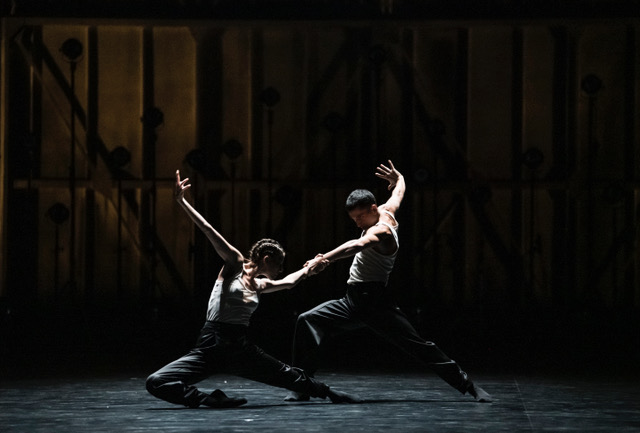Dance Review: Paris Opera Ballet’s “Body and Soul” — Dark and Potent Boogie
By Jessica Lockhart
Body and Soul generates a whirligig of passions — joy, frustration, pleasure, and rage.
An online performance of the Paris Opera Ballet’s performance of Crystal Pite’s Body and Soul, presented by the Jacob’s Pillow Dance Festival through July 15.

A scene from the Paris Opera Ballet’s Body and Soul. Photo: Julien Benhamou.
The pandemic shuttered the world. Now, as we reemerge, the art world and dance festivals are gingerly welcoming back their audiences. Jacob’s Pillow 2021 Dance Festival will be offering a scaled-down version this summer. There will be no indoor theater shows, but a few on-site outdoor presentations as well as online only performances. The opening week scheduled Dorrance Dance in-person and the Paris Opera Ballet online. The Paris Opera Ballet is the oldest national dance company; it was founded in 1661. This performance was the American Premiere of Body and Soul, created in 2019 by Crystal Pite.
Pite is a Canadian choreographer who customarily works with a number of close collaborators as she creates a new ballet. Her costume, set, and musical assistants helped her build the evening-length work for the Paris Opera Ballet. Body and Soul features a cast of 35 exceptional dancers whose efforts are enhanced by elegant costumes, a gorgeous soundscape, and evocative lighting. The piece is made up of three parts. Pite was obviously interested in transforming stage space: first we are in a dark intimate space, then a wide-open location, and finally we venture into a strange, other worldly place.
The ballet begins with two dancers sharing the stage in stillness: a stark beam of light shining down on them. A voice intones, “Figure I lies on the ground, figure 2 starts pacing. Right, left, right left. Repeat. Chin, neck, shoulder … a struggle.” The voice continues to describe every detail of the couple’s movements. This two-minute opening section establishes the central theme for the entire dance, which is an examination of conflict and connectedness. Pite uses the text’s repetition to explore how the voice-over can change tempo and timing and can subtly change moods. The text is alternately spoken, whispered, and shouted, each intonation triggering different emotions.
After the initial duet, the entire cast performs to the same voice-over. They repeat the requested movements, but not as individuals. We see two masses pitted against each other. Both men and women were costumed in black suits with long overcoats, white shirt, and tie. This formal look adds to the somber intensity. We see variation after variation on the same situation, as the dancers take various stabs at how the two figures (or groups) encounter each other. Sometimes it’s two angry mobs; it can be a woman and her dying lover. The exploration of pushing and pulling via various groupings continues, with the dancers shedding their coats and shirts to reveal undershirts — the sight adds a rawer feeling to their movements. Body and Soul generates a whirligig of passions — joy, frustration, pleasure, and rage. A dark and potent beauty runs throughout. Owen Belton’s original score serves the power of the text, nimbly layering voices, chants, sounds of waves, and many other ambient sounds.
Part Two was danced to Frederic Chopin’s Preludes, Op 28. At first, the classical music supplies a calming effect, enhanced by a stage that is now brightly lit and open. After a bit, the dancers begin to treat the Chopin preludes with a sense of humor.

A scene from the Paris Opera Ballet’s Body and Soul. Photo: Julien Benhamou.
Part Three begins with a black stage and sounds of creaking and whispering. We see outlines of some kind of insect or animal. The soundscape becomes eerie and searching. The background turns molten red and we see creatures with long pincer arms moving together in a pack. As they leave, a very different animal emerges on stage, covered in an elaborate fur mane and wearing a headdress filled with long shaggy hair. The creature’s face is covered so we can’t make out what kind of animal it is as it wanders about. The futurist “insects” return, and they follow the directions given by the voice-over. They begin to battle.
Most of the evening is a serious study of how people struggle to resolve disagreements and learn to get along. The piece’s unusual conclusion, with its violence, raises a difficult question. Was this turmoil really necessary?
At the end of Part Three, as the final insect creature capers off stage, we suddenly hear a bluesy garage-rock song. The fur animal reappears wearing bell bottoms. The “insects” return and shed their pincer arms. What looks like an assemblage of soul dancers and voguers move all together to a song entitled “Body and Soul.” The lyrics repeat a mantra: “I get what I want. Not all that I want. A piece of your heart. Your body and soul.” So that is Pite’s message! It is so fun and weird. It is almost as if the seriousness of the entire evening boils down to one idea. We are all one creature with the same basic desire: let’s boogie. Happy post-lockdown America, it’s time to dance.
Jessica Lockhart is a National Endowment for the Arts Fellow in Dance Criticism and has a BA in Communication from the University of Southern Maine. Lockhart is a Maine Association of Broadcasters award-winning independent journalist. Currently, she also works as program director at WMPG Community radio.
Tagged: Body and Soul, Crystal Pite, Jacobs-Pillow-Dance-Festival, Jessica Lockhart
